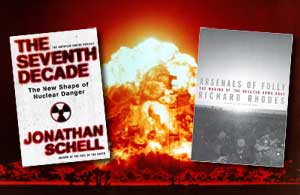Jason Epstein on the Nuclear Threat
Two new books by Richard Rhodes and Jonathan Schell paint a disturbing portrait of an era whose Dr. Strangeloves are still practicing their black art.
On a sultry day last summer as I walked along a narrow street in my Long Island village of Sag Harbor, I stopped to watch two boys not yet in their teens jousting with their bicycles, not astride them like knights but on foot, like antlered stags, thrusting their bikes at each other, parrying the blows by twisting their front wheels this way and that, their shirts drenched with sweat, their knees bloody, when they might more rationally have spent the day at the beach. On the curb stood two girls, transfixed, for whose sake this triumph of primal instinct over common sense — this mini-Iliad — was performed, a microcosm of our Hobbesian history and a warning to those who hope for a rational solution to the apocalyptic problem of nuclear proliferation.
The Seventh Decade: The New Shape of Nuclear Danger
By Jonathan Schell
Metropolitan Books, 272 pages
Arsenals of Folly: The Making of the Nuclear Arms Race
By Richard Rhodes
Knopf, 400 pages
In “Arsenals of Folly: The Making of the Nuclear Arms Race,” the third installment of his projected four-volume history of the nuclear age, Richard Rhodes reports that by the mid-1980s the world’s total nuclear stockpile had “increased to about 50,000 bombs and warheads with a combined explosive force of about 22,500 million tons of TNT, equivalent to fifteen million Hiroshimas,” the product mainly of a relative handful of maniacs in the Soviet Union and the United States working in secret with the explicit support of their respective governments and the tacit permission or indifference of their fellow citizens. Faced with this genocidal absurdity, Ronald Reagan and Mikhail Gorbachev proposed in Reykjavik in 1986 to entirely abolish their nuclear arsenals. (Reagan further proposed that a party be thrown for the world when the last weapon was scrapped.) Alas, no sooner had the two leaders celebrated their epochal agreement than it fell apart over Reagan’s foolish determination to continue testing what came to be called “Star Wars” — a B-movie fantasy to erect a defensive shield of space-based lasers against hostile nukes. Gorbachev, probably aware that Reagan’s Strategic Defense Initiative, or SDI as it was called, was nonsense, nevertheless refused to countenance space-based weapons even as fantasy, perhaps anticipating opposition from his own military-industrial complex if he returned to Moscow with an agreement to scrap Soviet nukes while letting Reagan try to weaponize space. Forty-four billion dollars later, SDI was finally abandoned in 1993, but at Reykjavik it provided the American war party a more valuable service than that for which it was intended: It killed the slight but real possibility that the two leaders could sell their grand démarche to their respective bureaucracies.
It was Richard Perle, the warmonger’s warmonger, who poisoned the chalice when he convinced Reagan at Reykjavik that Gorbachev’s demand that SDI experiments be confined to the laboratory rather than be performed in space would render the entire project impossible. Though Perle must have known, as many others did by this time, that SDI was a joke, he considered “his successful frustration of agreements at Reykjavik one of his most important achievements,” according to Thomas Graham, general counsel to the Arms Control and Disarmament Agency at the time. Should worse come to worst, what’s left of humanity can thank Richard Perle for destroying their world.
For years the Committee on the Present Danger, which included, among others, Perle, Paul Wolfowitz, Richard Pipes, Paul Nitze, Jeane Kirkpatrick, and Caspar Weinberger, had pampered the military-industrial complex by exaggerating the Soviet threat, despite abundant evidence that the Soviet Union was a dysfunctional bureaucracy precariously sustained by a crumbling economy founded on absurd economic assumptions and burdened by its own voracious military-industrial complex, which, as it was later revealed, had no intention of upending its privileged existence by starting a nuclear war. It was this threat exaggeration by Perle and others that led to the reciprocal escalations that resulted in the creation of 50,000 nuclear weapons equivalent to 15 million Hiroshimas, which led in turn to the meeting of the leaders at Reykjavic and Perle’s last-minute intervention to keep the bombs on target. Rhodes cites considerable evidence, including the testimony of two high-ranking Soviet generals, both of them participants in nuclear war planning during the Cold War, that “the Soviet government and general staff never followed a first strike doctrine, convinced that nuclear war would cause unacceptable damage to both countries,” to say nothing of what it would do to themselves. Nevertheless, the master doomsayer Richard Cheney, serving as Bush 41’s secretary of defense, told CNN that Gorbachev was a fraud who would “ultimately fail and a leader far more hostile to the West would follow.” Instead, Gorbachev presided over the liquidation of the Soviet Union and by abandoning his opposition to SDI joined the START talks, which would lead, Rhodes writes, “to the unilateral initiatives of autumn 1991, which may fairly be counted as the final, historic acts of demolition in the termination of the superpower nuclear arms race that had burdened and threatened the world since 1949.”
Rhodes ends his book on this optimistic note at the end of Bush 41’s term, adding that the issue of nuclear abolition “must be the subject of another” — and no doubt gloomier — book, for while the Cold War weapons were now being constrained, the Committee on the Present Danger remained on the prowl, rabid as ever in its quest for new threats to exaggerate.
While we await Rhodes’ account of these hobgoblins in his next book, we have Jonathan Schell’s appropriately grim “The Seventh Decade: The New Shape of Nuclear Danger,” which takes matters to the present day. Schell writes: “[George W.] Bush’s demotion of diplomatic treaties and his elevation of force … tore at the web of arms control treaties that had grown up over four decades. … He declined to revive the Comprehensive Test Ban Treaty … and … announced the United States withdrawal from the Anti Ballistic Missile Treaty. He also … weakened the Nuclear Non-Proliferation Treaty and left it to Under Secretary of State John Bolton to declare that ‘obligations of the nuclear powers to fulfill their disarmament commitments under Article Six (of the NPT) ‘did not exist,’ ” though any reading of the treaty would show that they did, if only in the breach.On the eve of the Iraq war, Richard Perle, expounding the revolutionary essence of the Bush Doctrine, wrote: “Saddam Hussein’s reign of terror is about to end. He will go quickly but not alone … he will take the UN down with him. … What will die is the fantasy of the UN as the foundation of a new world order … the liberal conceit of safety through international law administered by international institutions,” echoing perhaps inadvertently the disdain for the liberal conceit of the League of Nations by the would-be empires of the 1930s: Japan over its conquest of Manchuria, Germany over its occupation of the Ruhr, and Italy over its invasion of Ethiopia. What Perle saw instead of the liberal conceit of international law was an American new world order sustained not by treaty but by power: the fantasy of an American empire which for the moment lies smoldering in the wreckage of the Bush administration.
The United States and Russia hold nearly all the 27,000 nuclear weapons that currently exist, the larger part belonging to Russia while the American holdings are being modernized as a smaller but more powerful and flexible force. Further reductions are promised. But this démarche reflects more efficient packaging, not a significant reduction of overkill. A redesigned weapon the size of an artillery shell can now vaporize a major city: A few of them would obliterate New York or Los Angeles. A hundred or so would destroy life on Earth. With the Cold War ended, however, the purpose of these weapons has become obscure. With Talmudic intensity, Schell examines the administration’s Nuclear Posture Review of 2001 to learn the strategic policy by which these thousands of refurbished weapons are to be disposed. But “when it came to describing what mission the still immense arsenal would serve, the document [withdraws] into extreme generalities.” Nevertheless, from the “verbal mist of the NPR the … purpose of the American nuclear arsenal in the post Cold War era emerged: to dissuade, deter, defeat or annihilate — preventively, preemptively or in retaliation — any nation or other grouping of people … that militarily opposed or dreamed of opposing the United States.”
The Seventh Decade: The New Shape of Nuclear Danger
By Jonathan Schell
Metropolitan Books, 272 pages
Arsenals of Folly: The Making of the Nuclear Arms Race
By Richard Rhodes
Knopf, 400 pages
But for all his effort Schell still cannot say how an arsenal of 10,000 or so nuclear weapons, equal to several million Hiroshimas, can implement such a policy, nor can Linton Brooks, who served until January 2007 as director of the Energy Department’s National Nuclear Security Administration, which oversees the nation’s nuclear weapons infrastructure. Before he took this post, Brooks helped produce the January 2001 National Institute of Public Policy study “Rationale and Requirements for Nuclear Forces and Arms Control,” which was regarded by many observers as a blueprint for George W. Bush’s 2002 Nuclear Posture Review. He was nevertheless dismissed by the Department of Energy in January 2007, not because he was unable to answer Schell’s question of how these weapons may be used in any future war, but because he was held responsible for security lapses at the country’s nuclear labs. Otherwise he seems to have been an industrious administrator who ordered his staff to “examine advanced [thermonuclear] concepts that could contribute to our nation’s security. …” He went on to say: “We must … ensure that we close any gaps that may have opened in the past decade in our understanding of the possible military applications of atomic energy. No novel nuclear weapons concept developed by any other nation should ever come as a technical surprise to us.” For Frank von Hippel, a physicist and arms control specialist at Princeton, these orders were “really very distressing. They’re saying, ‘Go after it guys. We’re back in the fifties. Come up with all the crazy ideas you can, if there are any left out there.’ This is fossil Cold War mentality surfacing again.”
Yet Linton Brooks for all his insider’s knowledge confesses in a speech he gave in January 2007 at a Lawrence Livermore-Los Alamos Conference that he too doesn’t know what these militarily useless weapons are for. “The biggest question in the area of doctrine and operations — indeed arguably the most important question facing us in any nuclear area — is the fundamental purpose or purposes of nuclear weapons in the 21st Century. I’m not thinking of the assure, dissuade, deter and defeat typology. It is fine at the conceptual level. Rather I think we lack consensus on the concrete types of situations (other than the residual role in deterring large scale attack from Russia) in which nuclear weapons are relevant.”
Since even Brooks himself doesn’t know what to do with these infinitely destructive weapons, the obvious answer is multilateral nuclear disarmament under strict international control. From a technological point of view, abolition is simply a matter of dismantling the warheads and sequestering the fissile material, far simpler for example than preventing AIDS or preserving what is left of the atmosphere. The real problem is dismantling the multilateral nuclear bureaucracy, for, as Schell admits, “now as then [when Truman decided to drop the bomb] the easier thing is to go with the momentum.” Brooks ends his talk to the nuclear establishment by telling it not to worry. We may not know what we’re doing but your jobs are safe: “The political conditions for abolition are unlikely and the technology to verify abolition does not exist.” Mr. Mohamed ElBaradei of the International Atomic Energy Agency might dispute the latter point, and political conditions do change and soon will. Perhaps in Richard Rhodes’ fourth and final volume we can all share the optimism that proved premature in his present book, or perhaps not.
Jason Epstein is former editorial director of Random House and the first recipient of the National Book Award for Distinguished Service to American Letters. He has edited many well-known writers, including Norman Mailer, Vladimir Nabokov, E.L. Doctorow, Philip Roth, and Gore Vidal. He also edited McGeorge Bundy’s “Danger and Survival: Choices About the Bomb in the First Fifty Years” and Robert Scheer’s “With Enough Shovels: Reagan, Bush and Nuclear War.”
Your support matters…Independent journalism is under threat and overshadowed by heavily funded mainstream media.
You can help level the playing field. Become a member.
Your tax-deductible contribution keeps us digging beneath the headlines to give you thought-provoking, investigative reporting and analysis that unearths what's really happening- without compromise.
Give today to support our courageous, independent journalists.








You need to be a supporter to comment.
There are currently no responses to this article.
Be the first to respond.